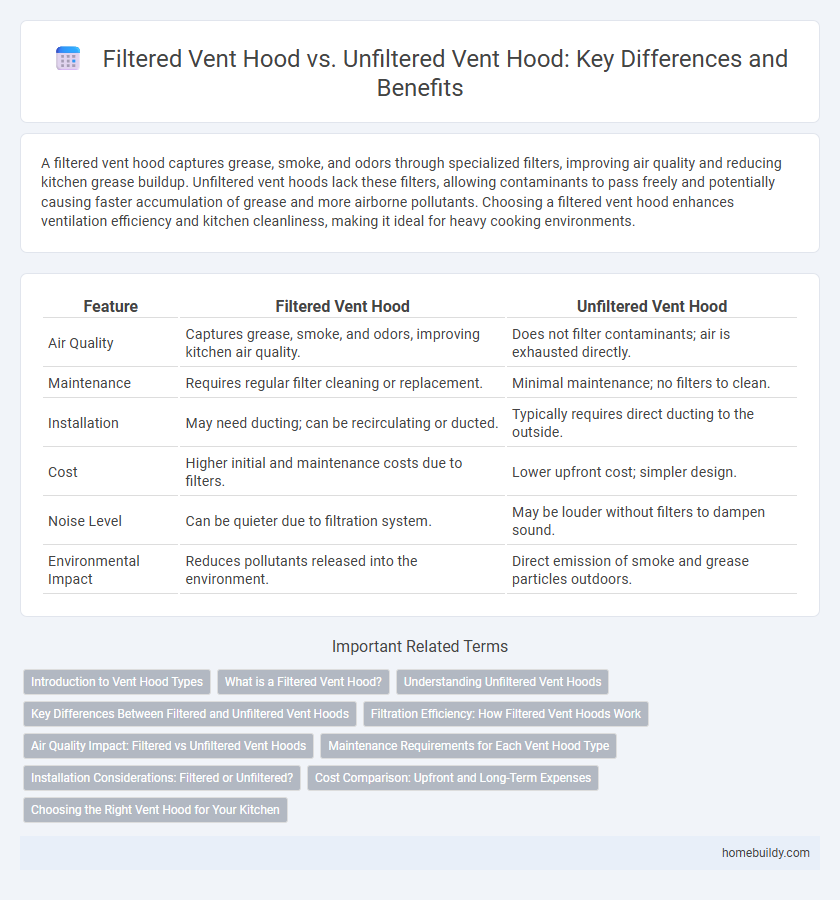A filtered vent hood captures grease, smoke, and odors through specialized filters, improving air quality and reducing kitchen grease buildup. Unfiltered vent hoods lack these filters, allowing contaminants to pass freely and potentially causing faster accumulation of grease and more airborne pollutants. Choosing a filtered vent hood enhances ventilation efficiency and kitchen cleanliness, making it ideal for heavy cooking environments.
Table of Comparison
| Feature | Filtered Vent Hood | Unfiltered Vent Hood |
|---|---|---|
| Air Quality | Captures grease, smoke, and odors, improving kitchen air quality. | Does not filter contaminants; air is exhausted directly. |
| Maintenance | Requires regular filter cleaning or replacement. | Minimal maintenance; no filters to clean. |
| Installation | May need ducting; can be recirculating or ducted. | Typically requires direct ducting to the outside. |
| Cost | Higher initial and maintenance costs due to filters. | Lower upfront cost; simpler design. |
| Noise Level | Can be quieter due to filtration system. | May be louder without filters to dampen sound. |
| Environmental Impact | Reduces pollutants released into the environment. | Direct emission of smoke and grease particles outdoors. |
Introduction to Vent Hood Types
Filtered vent hoods incorporate mesh or baffle filters designed to trap grease, smoke, and airborne particles, improving air quality and reducing kitchen contamination. Unfiltered vent hoods lack these filtering components, providing basic ventilation by expelling air without capturing pollutants. Choosing between filtered and unfiltered vent hoods depends on kitchen usage intensity, maintenance preferences, and local air quality regulations.
What is a Filtered Vent Hood?
A filtered vent hood uses a built-in filtration system to capture grease, smoke, and airborne particles, improving indoor air quality and reducing kitchen odors. These hoods typically incorporate charcoal or mesh filters, which trap contaminants before exhaust is released outside. Filtered vent hoods are essential in commercial kitchens and homes that require efficient ventilation and minimal environmental impact.
Understanding Unfiltered Vent Hoods
Unfiltered vent hoods operate by directly exhausting kitchen air without any filtration, allowing grease, smoke, and odors to pass through freely. These hoods are typically more affordable and require less maintenance but may contribute to increased buildup in ductwork and surrounding areas. Understanding the trade-offs between unfiltered vent hoods and filtered alternatives is essential for optimizing kitchen ventilation efficiency and indoor air quality.
Key Differences Between Filtered and Unfiltered Vent Hoods
Filtered vent hoods include built-in filters that trap grease, smoke, and odors, improving indoor air quality and reducing buildup on ductwork. Unfiltered vent hoods rely solely on ventilation without capturing contaminants, which can lead to more frequent cleaning and potential exposure to airborne particles. The choice between filtered and unfiltered vent hoods impacts maintenance frequency, air purity, and overall kitchen hygiene.
Filtration Efficiency: How Filtered Vent Hoods Work
Filtered vent hoods utilize multi-stage filtration systems, often combining grease filters and activated carbon layers, to capture airborne particles, grease, and odors with filtration efficiencies typically exceeding 90%. These hoods operate by drawing contaminated air through high-performance filters that trap particulates before exhausting air outside or recirculating it, significantly reducing indoor air pollutants. In contrast, unfiltered vent hoods simply expel air without any particle removal, resulting in lower air quality and increased maintenance from grease buildup on surrounding surfaces.
Air Quality Impact: Filtered vs Unfiltered Vent Hoods
Filtered vent hoods significantly improve indoor air quality by capturing grease, smoke, and airborne contaminants before exhaust, reducing pollutants and odors in kitchens. Unfiltered vent hoods allow particulate matter and fumes to disperse freely, leading to higher levels of indoor air pollution and potential respiratory issues. Implementing filtered vent hoods is essential for maintaining healthier environments in both residential and commercial cooking spaces.
Maintenance Requirements for Each Vent Hood Type
Filtered vent hoods require regular cleaning or replacement of filters to maintain optimal airflow and prevent grease buildup, which can lead to fire hazards. Unfiltered vent hoods have lower maintenance demands but may accumulate grease and airborne particles faster on internal components, necessitating more frequent professional cleaning. Proper maintenance of either vent hood type ensures efficient ventilation and prolongs the lifespan of kitchen exhaust systems.
Installation Considerations: Filtered or Unfiltered?
Filtered vent hoods require more complex installation due to the integration of filtration systems that need regular maintenance and space for filter replacement. Unfiltered vent hoods offer simpler installation with direct ducting but may necessitate more frequent duct cleaning to prevent grease buildup. Choosing between filtered or unfiltered vent hoods depends on kitchen ventilation needs, local building codes, and maintenance capacity.
Cost Comparison: Upfront and Long-Term Expenses
Filtered vent hoods typically have higher upfront costs due to the inclusion of filters that need regular replacement, increasing long-term maintenance expenses. Unfiltered vent hoods offer lower initial investment but may incur higher costs over time because of increased kitchen grease buildup and more frequent duct cleaning requirements. Evaluating both options requires factoring in filter replacement frequency and potential savings from reduced duct maintenance for filtered systems.
Choosing the Right Vent Hood for Your Kitchen
Choosing the right vent hood for your kitchen involves weighing the benefits of filtered versus unfiltered models based on cooking habits and kitchen layout. Filtered vent hoods use mesh or baffle filters to trap grease and particulates, improving air quality and reducing ductwork contamination, ideal for heavy frying or grilling. Unfiltered vent hoods offer straightforward ventilation with less maintenance, suitable for kitchens with excellent natural airflow or less intensive cooking, ensuring efficient smoke and odor removal without filter cleaning.
Filtered vent hood vs Unfiltered vent hood Infographic

 homebuildy.com
homebuildy.com